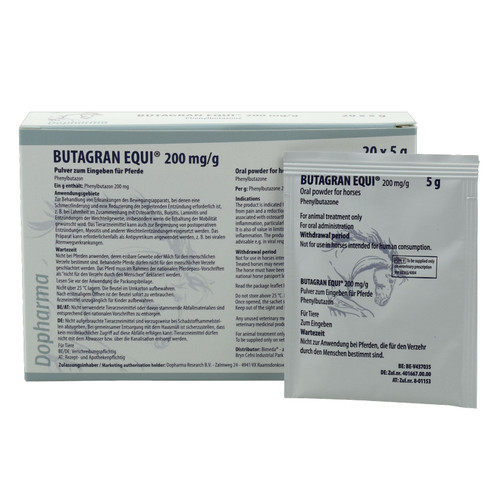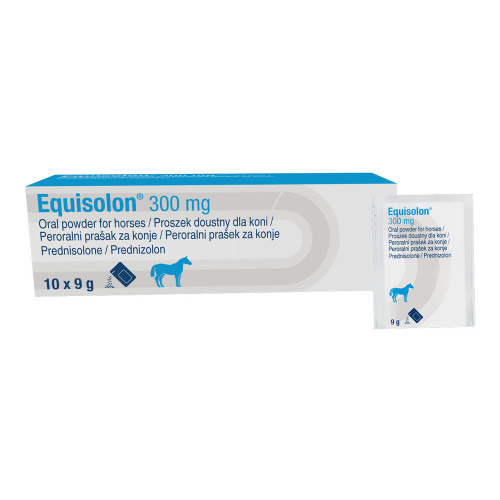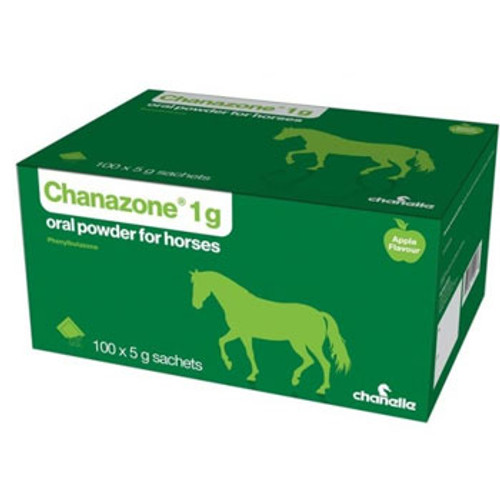Butagran Equi 200mg/g, Oral Powder for Horses 100g x 5g.
Qualitative and quantitative composition
Per g:
Active substance:
Phenylbutazone 200 mg
Also contains excipients including:
Butter vanilla flavour
Pharmaceutical form
Oral powder.
White powder.
Clinical particulars
Target species
Horses
Indications for use
The product is indicated for the treatment of musculo-skeletal conditions where relief from pain and a reduction in the associated inflammation is required e.g. in lameness associated with osteoarthritic conditions, bursitis, laminitis and soft tissue inflammation, particularly where continued mobility is considered desirable.
It is also of value in limiting post-surgical inflammation, myositis and other soft tissue inflammation.
The product can be used as an anti-pyretic where this is considered advisable e.g. in viral respiratory infections.
Contra-indications
Do not use in animals with known hypersensitivity to the active ingredient.
Use is contraindicated in animals suffering from cardiac, hepatic or renal disease, where there is the possibility of gastrointestinal ulceration or bleeding or where there is evidence of a blood dyscrasia.
Special warnings for each target species
The clinical effects of phenylbutazone can be evident for at least three days following cessation of therapy. This should be borne in mind when examining horses for soundness.
FEI regards phenylbutazone as a prohibited substance, it should not be administered at least 8 days before the competition.
Special precautions for use
i) Special precautions for use in animals
Do not exceed the stated dose as the therapeutic index of phenylbutazone is low.
Use in any animal less than 6 weeks of age or in aged animals may involve additional risk. If such use cannot be avoided, animals may require careful clinical management.
Avoid use in any dehydrated, hypovolaemic or hypotensive animal as there is a potential risk of increased renal toxicity. Keep water readily available during the treatment period to avoid dehydration.
NSAIDs can cause inhibition of phagocytosis and hence in the treatment of inflammatory conditions associated with bacterial infections, appropriate concurrent antimicrobial therapy should be instigated.
ii) Special precautions to be taken by the person administering the veterinary medicinal product to animals
Wash hands after use.
Avoid contact with the eyes. In case of accidental eye contact, irrigate eyes with plenty of clean water. If irritation persists, seek medical advice.
Care should be taken to avoid inhaling or ingesting the powder.
In the event of accidental inhalation or ingestion seek medical advice and show the product packaging.
Adverse reactions
In common with other NSAIDs that inhibit prostaglandin synthesis, there may be gastric and/or renal intolerance. This is usually associated with overdosage and such events are rare. Recovery is usual on cessation of treatment and following the initiation of supportive symptomatic therapy.
Ponies are very sensitive to gastric ulceration with this product, even at therapeutic doses (diarrhoea, ulceration in the mouth and hypoproteinaemia may also be seen).
Use during pregnancy, lactation or lay
Pregnancy:
Care should be exercised if administered to pregnant mares. Although no adverse effects of phenylbutazone on the foetus or maintenance of pregnancy have been reported during field use, no definitive safety studies have been carried out in the mare.
Foetotoxic effects of phenylbutazone have been recorded in experimental animal species at high dose levels.
Lactation:
The safety of the product in lactating mares has not been demonstrated
If the administration of phenylbutazone to pregnant or lactating mares is considered essential the potential benefits should be weighed against the potential hazard to the mare and/or foal.
Avoid use around time of parturition.
Interactions
Concurrent administration of potential nephrotoxic drugs should be avoided.
Phenylbutazone is extensively bound to plasma proteins. It may displace other drugs that are highly protein-bound e.g. some sulphonamides, warfarin or it may itself be displaced to produce an increase in non-bound pharmacologically active concentrations, which can lead to toxic effects.
Concurrent therapy with other therapeutic agents should be undertaken with caution due to the risk of metabolic interactions. Phenylbutazone may interfere with the metabolism of other drugs e.g. warfarin, barbiturates, with resultant toxicity.
There is evidence to indicate that the pharmacokinetics of penicillin and gentamicin products may be affected by concurrent administration of products containing phenylbutazone with a possible reduction of therapeutic efficacy, since tissue penetration may be reduced. The distribution of other drugs given concurrently may also be affected.
Do not administer other NSAIDs concurrently or within 24 hours of each other.
Phenylbutazone induces hepatic microsomal enzyme activity.
Amounts to be administered and administration route
For oral administration.
For each 450 kg of body weight the following dosage guide should be used according to individual response:
Day 1: Two sachets or 10 g of product twice daily (equivalent to 4.4 mg of phenylbutazone/kg of BW on each occasion).
Day 2-4: One sachet or 5 g of product twice daily (equivalent to 2.2 mg of phenylbutazone/kg of BW on each occasion) followed by one sachet or 5 g of product daily (2.2 mg of phenylbutazone/kg of BW daily) or on alternate days as required.
If no response is evident after 4-5 days, discontinue treatment. Hay may delay the absorption of phenylbutazone and so the onset of a clinical effect. It is advisable not to administer hay immediately prior to, or during the administration of the product.
For ease of administration the product may be mixed with a limited quantity of bran or oats.
Overdose
Overdosing may result in gastric and large intestinal ulceration and general enteropathy. Renal papillary damage may also occur with impaired renal function. Subcutaneous oedema, especially under the jaw may become evident due to plasma protein loss.
There is no specific antidote. If signs of possible overdosage occur, treat the animal symptomatically.
Withdrawal periods
Not for use in horses intended for human consumption.
Treated horses may never be slaughtered for human consumption.
The horse must have been declared as not intended for human consumption under national horse passport legislation.
Pharmacological particulars
Pharmacotherapeutic group: Anti-inflammatory and antirheumatic products, non-steroids
ATCvet-code: QM01AA01
Pharmaceutical particulars
Excipients
Glucose Monohydrate
Methylhydroxypropylcellulose (Hypromellose)
Butter vanilla flavour
Major incompatibilities
Do not mix this product with any other veterinary medicinal product.
Shelf life
Shelf life of the veterinary medicinal product as packaged for sale: 18 months.
Shelf life after first opening the immediate packaging: use immediately after opening
Special precautions for storage
Do not store above 25°C
Immediate packaging
- Heat-sealed PET/LDPE/aluminium foil/LDPE laminated sachet of 5 grams of product;
- Heat-sealed aluminium foil/LDPE/paper/LDPE laminated sachet of 5 grams of product.
- Sachets are packed in a cardboard box containing 100 sachets for single use.
Shipping charges mainland GB zone1
| Value | Weight | Delivery Charge |
| Over £49.00 | Any Weight | FREE |
| Under £49.00 | No weight limit | £4.50 |
| Under £49.00 | Under 250 grams | £3.49 |
Most orders are despatched the same day and standard delivery is 3 to 5 working days from despatch. FAST Expedited options are available at extra cost - these usually arrive in 24-48hrs from dispatch but delays are possible during busy periods.
Postcodes outside of Zone 1 (including some areas within mainland UK) may incur extra carriage charges due to surcharges imposed by the couriers. These will be calculated on the website at the checkout.
NB: Orders placed with faster delivery must be placed before 13:00 to ensure same day dispatch (excluding weekends and bank holidays). Please also check on the product page that the items ordered show 'In Stock' otherwise your order will be delayed until the stock becomes available, which in most cases will only be 24hrs.
Estimated "Usually shipped in" information is shown against most products
Overseas orders
We no longer send goods outside of the UK.
Prescription Items
Prescription items will be sent on receipt of a valid signed and dated prescription.
Pick up
We offer a pickup service for orders placed over the phone.
Please ring us on 01833 641112 for more information.
Refrigerated Items
Refrigerated items will be sent by carrier or express delivery at a cost of £7.50, with coolpacks, unless you pay for a premium for a refrigerated delivery. We will contact you prior to despatch for your instructions.
We want you to be completely satisfied with any purchase. If not any item* can be returned to us within 14 days of receipt for exchange or refund Please give us a ring for a returns number on 01833 641112 or alternatively email sales@hyperdrug.co.uk to obtain a returns number.
*Due to legal requirements medicines may not be returned except to correct an error in despatch or in response to an "official recall". If an item is believed to be faulty it should be returned for inspection and it may be necessary to forward it to the manufacturers for testing before replacements or refunds can be authorised. This does not infringe legal rights. Please contact our customer services for a "Returns Number" which must appear on the outside of the package or it will not be accepted. We advise customers to use an insured method of shipping and to retain proof of despatch. We may refuse returns on products specially obtained or manufactured to order. Items must be returned unsoiled and unused and sent adequately packed and carriage paid.








